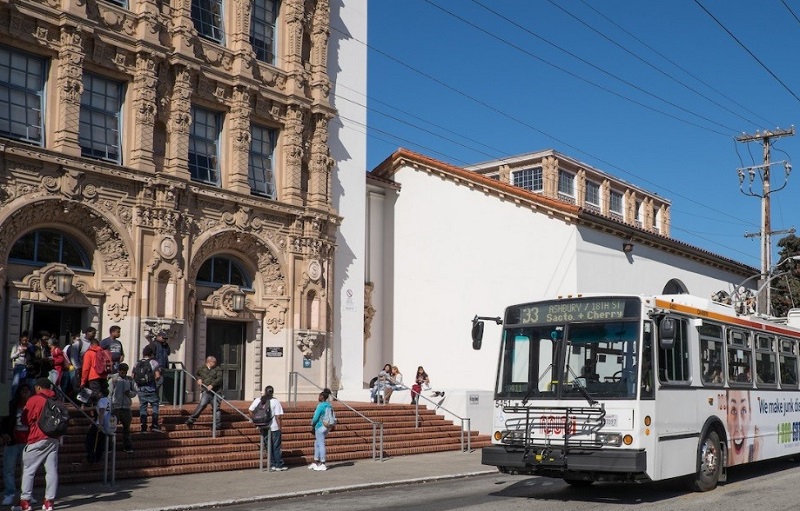The new school year started yesterday for San Francisco Unified School District’s 57,000 students. Many other schools will start up classes soon, too. So, we’re making sure students can travel safely and affordably with initiatives like Free Muni for Youth, discounted youth fares, crossing guards and the Muni Transit Assistance program.

Mission High School students mingle as the 33 Ashbury-18th Street passes.
Plan Your Trip
We want it to be easy for students to ride transit to or from school. In fact, almost half of SFUSD’s students take Muni. Every middle and high school in the school district is served by at least one Muni route. There's even a special "school trippers" service ― supplemental Muni routes that begin after school hours and serve middle and high schools throughout the city. But if transit, walking or bicycling isn't possible, and you do need to drive and drop your children off, please remember to:
- Pull into a passenger loading zone for drop-off. If there is no passenger loading zone or space available, park in a legal parking space in the area.
- Drop your child off at the curb on the school side of the street rather than crossing into oncoming traffic or having your child run across the street.
- Talk with your family about crossing safely and remember to:
- Stop at the curb or edge of the street.
- Look left, right, left and over your shoulder for traffic before you cross a street.
- Wait until no traffic is coming to begin crossing.
- Keep looking for traffic until you have finished crossing.
- Walk, don’t run across the street.
- Don’t use your phone when crossing the street.
A Partnership with the San Francisco Police Department
As was announced on Friday, in an effort led by Mayor Lee, we're joining SFPD and other city partners to increase safety on San Francisco streets.
In support of the city’s Vision Zero goal to eliminate all traffic deaths, police officers will be enhancing traffic enforcement near 10 targeted schools for the entire week in addition to existing traffic enforcement efforts. These schools are also near the city’s Vision Zero High Injury Network, where 70 percent of severe and fatal traffic injuries happen on just 12 percent of San Francisco’s streets. Enforcement will focus on speed, failure to yield to pedestrians, bicycle lanes and other violations that jeopardize pedestrian and bicyclist safety.
Even if you’re not shuttling kids to school, remember now that it’s back in session, smaller people who are still learning to navigate our streets will be walking and bicycling to school. Special attention should be given when entering school zones, passing Muni transit stops, or approaching marked or unmarked crossings. Also, be aware that passing a school bus with flashing red lights is prohibited, from either direction, unless on a divided highway, with two or more lanes in each direction.
The SFMTA is continually seeking ways to make our streets safer for our most vulnerable residents with programs like:
Crossing Guards: The SFMTA is ramping up its School Crossing Guard Program. Yesterday also marked the first day for nine new school crossing guards with another 13 beginning after Labor Day. In total, the SFMTA has grown its School Crossing Guard Program this year to 192 crossing guards, staffing 151 corners at 107 private and public schools citywide.
Bike Education: More and more people in San Francisco, and just not children, see bicycles as more than just a convenient way to get around; it's a necessity. Creating a connected network of safe, low-stress streets for bicycling is crucial to keeping students safe while they bike to school. The San Francisco Bicycle Coalition is also a great source for information on safety and navigating traffic workshops.
Free Muni for low-to-moderate income students: The Free Muni for Youth Program provides free Muni services for low to moderate income city youth between the ages of five and 18 (students enrolled in Special Education Services and the English Learner Program are eligible until the age of 22) to help meet their transportation needs whether it be in the morning or afternoon. Since Free Muni for Youth began in March 2013, nearly 34,500 youth have enrolled in the program.
Applications are available for those who have not had time to sign up for the Free Muni for Youth Program, and are between the ages 5-18. They can still get a discounted fare of $1.25 when using a Clipper card ($1.35 with cash) to ride on Muni with a valid identification.
Muni Transit Assistance Program MTAP: Another way we work to make student travel safer is by using the Muni Transit Assistance Program.
Since launching in 1996, MTAP works with and trains members of the community in conflict resolution who then ride on specific routes with the purpose of diffusing and deterring any conflicts, acts of vandalism, and who assist the bus operators as needed.
Step Up to Muni Program
During the past summer, students who are transitioning from elementary school to one of four SFUSD middle schools had an opportunity to learn the ropes on how to take public transportation to school independently, among other valuable lessons.
For the past two years, the SFMTA has been participating in the school district's week-long Step Up Program to help students better understand their transportation options. The program contains skits and songs about using a Clipper Card, bus etiquette, demonstrations on loading bicycles on a Muni bus and traffic safety tips. Students also had the opportunity to meet members of the Muni Transit Assistance Program.